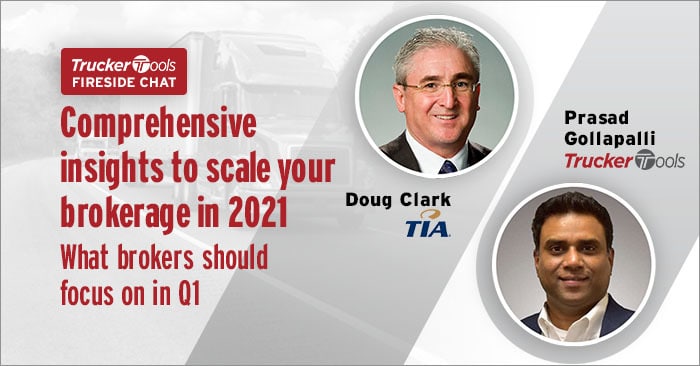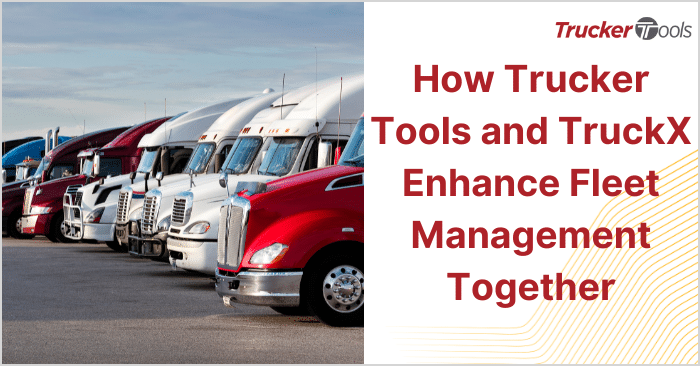Trucker Tools recently hosted a webinar entitled Comprehensive Insights To Scale Your Brokerage in 2021: What Brokers Should Focus on in Q1. The webinar featured Trucker Tools’ founder and CEO Prasad Gollapalli, who was joined by Doug Clark, an advisor at the Transportation Intermediaries Association and a 30-year veteran of the transportation industry. The discussion centered on best practices for logistics providers and brokers who are trying to navigate tight capacity markets and want to improve carrier loyalty. This lively discussion produced some valuable insights about what’s happening currently in the freight markets and how you can continue to grow in 2021.
Poll Results Show Expansion of Customer Base,
Capacity Crunch Top Concerns
To kick off the webinar, we asked the brokers and 3PLs in attendance what their top concerns are in 2021. Seventy-one percent of those who answered the poll said that their top concern is expanding their customer base, followed by a three way tie at 43 percent each for market volatility, tightening capacity and building a solid carrier network. Later on in the webinar, we polled attendees about the current capacity crunch. Eighty percent of attendees responded that while capacity is tight, it’s not as severe as it has been previously. Another poll during our webinar found that 64 percent of those in attendance use QuickPay to improve carrier loyalty.
What’s Unique About the Current Capacity
Crunch
“Obviously how much freight is out there on the road is going to dictate how much capacity there is,” said Clark. “Usually you get a little bit of breathing room where rates and demand slide back the other way, but right now there is a lot of demand for capacity. Have we seen the pricing go down? Absolutely. Have we seen it go back to 2018 or 2019 levels? No way. It’s very, very different right now. All of us were anticipating lower demand in 2021, and we’re getting that, but we’re still getting a lot of demand for capacity.”
“Obviously how much freight is out there on the road is going to dictate how much capacity there is,” said Clark. “Usually you get a little bit of breathing room where rates and demand slide back the other way, but right now there is a lot of demand for capacity. Have we seen the pricing go down? Absolutely. Have we seen it go back to 2018 or 2019 levels? No way. It’s very, very different right now. All of us were anticipating lower demand in 2021, and we’re getting that, but we’re still getting a lot of demand for capacity.”
While you’re probably used to dealing with the ups and downs of markets throughout the year, what’s made the current tight capacity market challenging is its level of unpredictability. Dealing with employees being out because of COVID-19 infections and exposures has made a tight capacity even more difficult for brokers and 3PLs. With employees working from home, you also may have added additional steps to your everyday processes that are burdensome for back office staff. Resolving problems such as incorrect BOLs may involve multiple email messages with a co-worker instead of a quick conversation at someone’s desk.
Use Technology To Reduce One-and-Done
Transactions, Create “Stickier” Relationships with Carriers
Clark pointed out during the webinar that freight brokers in the past have used a Rolodex, number two pencils and sticky-notes to keep track of carriers. However, times have changed and today’s brokers and 3PLs must leverage technology to its fullest to keep carriers sticky and moving their shippers’ loads. Technology offers new opportunities to reduce one-and-done relationships with carriers.
“When you set up a carrier for a one-time load, you are creating a database for the future,” advised Clark. “What we need to be doing, what we should be doing, is continuing to prepare for the future, which is machine-driven. When we think about what the future should hold for our database of carriers, we should get as much information as possible from those carriers that we set up because eventually you’re not going to be the one going back to read that information — technology is going to be reading that information. Technology gives you the ability to contact the carrier quickly. You even can set it up so that technology will send an email to the carrier so that you’re getting to them right away.”
“Technology gives you the ability to contact the carrier quickly. You even can set it up so that technology will send an email to the carrier so that you’re getting to them right away.”
Differentiate Yourself from Other Brokers/3PLs
with New SOPs
“If you get a carrier on the phone, you should update their carrier information and ask them where their trucks will be next week,” advised Clark. “Maybe you have a satellite office in Boston and you can get them a load there. When it comes to execution, we’re not always incentivized to do things like that, so we have to create new standard operating procedures going forward. Most brokers will call up a carrier and say, ‘Have you got a truck? Thanks, goodbye.’ That’s just not memorable.”
Clark also noted that many brokers and 3PLs often aren’t yet fully leveraging the power of current technology to their advantage. He recommends gaining a full understanding of how technology can help you and how you can integrate it with your current service offerings. Clark recommends that brokers and 3PLs keep it simple with technology initially and focus on increasing efficiency and employee productivity.
For more of our conversation with Doug Clark, watch the full webinar, Comprehensive Insights To Scale Your Brokerage in 2021: What Brokers Should Focus on in Q1.
Schedule a free demo of Trucker Tools’ real-time freight tracking platform, digital freight matching and Book-It-Now®.






